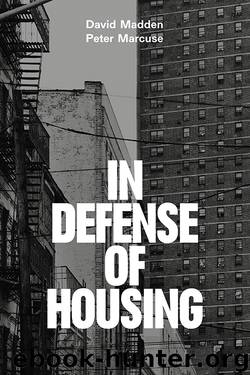In Defense of Housing by Peter Marcuse & Peter Marcuse

Author:Peter Marcuse & Peter Marcuse
Language: eng
Format: epub
Publisher: Verso Books
This is the richest and best developed country in the world. Who made it so? The rich? No. The Police Commissioner? No. The poor made it so. The only cure for this rent evil and all these evils is socialism. We must work together, one for all, all for one. Down with the rents!16
Red flags—actually petticoats that had been dyed red—hung from the tenant strikers’ windows.17 But the anticapitalist rhetoric enabled a swell of anticommunist sentiment to be whipped up against them, and at the request of landlords, the courts issued several thousand eviction notices, effectively breaking the strike.
The next major wave of mobilization, which lasted from 1917 to 1920, was perhaps the largest and most radical housing uprising in New York’s history. The movement was broader than in the past, involving not only Jewish families but also Italian and Irish tenants in Brooklyn, Harlem, and the Lower East Side.18
Housing insurrection seized New York. At a mass meeting in Beethoven Hall on East 5th Street,19 Baruch Charney Vladeck, the labor leader, journalist, and Socialist member of the city’s Board of Aldermen, called for a citywide rent strike. If every building on every block was organized, he argued, the courts and marshals would be overwhelmed and overpowered. Vladeck proclaimed, “Call it Bolshevism or anarchism, but I call it one of the tenets of real Americanism, when the people of the city get together to better their conditions.” Jacob Panken, Socialist Party member and municipal judge, urged the crowd to take over the under-occupied luxury buildings of Fifth Avenue and Riverside Drive. “Just as the Government had the power to conscript life so can New York conscript these dwelling places,” he argued.20
A series of tenant unions were formed throughout the city: first in Washington Heights, followed by Williamsburg, Harlem, Brownsville, Borough Park, Tremont, University Heights, and elsewhere. These unions combined into the Greater New York Tenants League, and eventually the Federation of Tenants Organizations of Greater New York.21 Most of them were deeply inspired by socialist ideals, and often had strong organizational links to the Socialist Party. The East Harlem Tenants League, for example, was based in a local Socialist office. Party politicians like Vladeck, Panken, and Abraham Beckerman promoted the tenant movement as part of their broader political activity. William Karlin, candidate for municipal judge and a former state assemblyman, declared in 1919, “The Socialist Party does not say you should pay less rent. It says you shouldn’t pay any rent … It is in the Socialist programme that the people shall take the homes and all the land and keep it.”22
The idea of left-wing parties and labor unions allied with tenants just trying to make ends meet terrified the city’s real estate establishment. A member of Mayor John Hylan’s Housing Conference Committee declared, “We are approaching a crisis in the housing situation … Unless radical action is taken, something drastic will happen.”23 One landlord was deeply alarmed at the formation of what he called a “tenant’s soviet” in his building.24
Download
This site does not store any files on its server. We only index and link to content provided by other sites. Please contact the content providers to delete copyright contents if any and email us, we'll remove relevant links or contents immediately.
The Secret History by Donna Tartt(18952)
The Social Justice Warrior Handbook by Lisa De Pasquale(12170)
Thirteen Reasons Why by Jay Asher(8849)
This Is How You Lose Her by Junot Diaz(6839)
Weapons of Math Destruction by Cathy O'Neil(6221)
Zero to One by Peter Thiel(5736)
Beartown by Fredrik Backman(5683)
The Myth of the Strong Leader by Archie Brown(5463)
The Fire Next Time by James Baldwin(5390)
How Democracies Die by Steven Levitsky & Daniel Ziblatt(5175)
Promise Me, Dad by Joe Biden(5117)
Stone's Rules by Roger Stone(5055)
A Higher Loyalty: Truth, Lies, and Leadership by James Comey(4909)
100 Deadly Skills by Clint Emerson(4883)
Rise and Kill First by Ronen Bergman(4741)
Secrecy World by Jake Bernstein(4703)
The David Icke Guide to the Global Conspiracy (and how to end it) by David Icke(4660)
The Farm by Tom Rob Smith(4469)
The Doomsday Machine by Daniel Ellsberg(4453)
